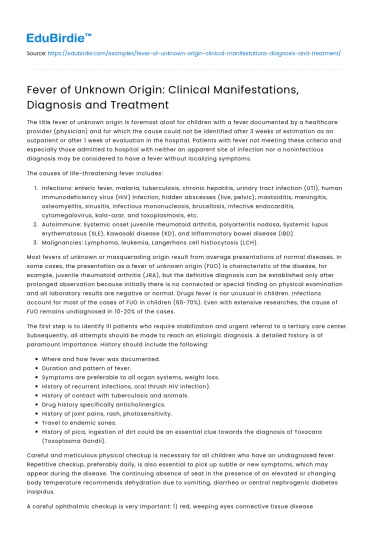The title fever of unknown origin is foremost aloof for children with a fever documented by a healthcare provider (physician) and for which the cause could not be identified after 3 weeks of estimation as an outpatient or after 1 week of evaluation in the hospital. Patients with fever not meeting these criteria and especially those admitted to hospital with neither an apparent site of infection nor a noninfectious diagnosis may be considered to have a fever without localizing symptoms.
The causes of life-threatening fever includes:
Save your time!
We can take care of your essay
- Proper editing and formatting
- Free revision, title page, and bibliography
- Flexible prices and money-back guarantee
- Infections: enteric fever, malaria, tuberculosis, chronic hepatitis, urinary tract infection (UTI), human immunodeficiency virus (HIV) infection, hidden abscesses (live, pelvic), mastoiditis, meningitis, osteomyelitis, sinusitis, infectious mononucleosis, brucellosis, infective endocarditis, cytomegalovirus, kala-azar, and toxoplasmosis, etc.
- Autoimmune: Systemic onset juvenile rheumatoid arthritis, polyarteritis nodosa, Systemic lupus erythematosus (SLE), Kawasaki disease (KD), and Inflammatory bowel disease (IBD).
- Malignancies: Lymphoma, leukemia, Langerhans cell histiocytosis (LCH).
Most fevers of unknown or masquerading origin result from average presentations of normal diseases. In some cases, the presentation as a fever of unknown origin (FUO) is characteristic of the disease, for example, juvenile rheumatoid arthritis (JRA), but the definitive diagnosis can be established only after prolonged observation because initially there is no connected or special finding on physical examination and all laboratory results are negative or normal. Drugs fever is nor unusual in children. Infections account for most of the cases of FUO in children (60-70%). Even with extensive researches, the cause of FUO remains undiagnosed in 10-20% of the cases.
The first step is to identify ill patients who require stabilization and urgent referral to a tertiary care center. Subsequently, all attempts should be made to reach an etiologic diagnosis. A detailed history is of paramount importance. History should include the following:
- Where and how fever was documented.
- Duration and pattern of fever.
- Symptoms are preferable to all organ systems, weight loss.
- History of recurrent infections, oral thrush HIV infection).
- History of contact with tuberculosis and animals.
- Drug history specifically anticholinergics.
- History of joint pains, rash, photosensitivity.
- Travel to endemic sones.
- History of pica, ingestion of dirt could be an essential clue towards the diagnosis of Toxocara (Toxoplasma Gondii).
Careful and meticulous physical checkup is necessary for all children who have an undiagnosed fever. Repetitive checkup, preferably daily, is also essential to pick up subtle or new symptoms, which may appear during the disease. The continuing absence of seat in the presence of an elevated or changing body temperature recommends dehydration due to vomiting, diarrhea or central nephrogenic diabetes insipidus.
A careful ophthalmic checkup is very important: 1) red, weeping eyes connective tissue disease, specifically polyarteritis nodosa; 2) bulbar conjunctivitis Kawasaki disease (leptospirosis); 3) petechial conjunctival hemorrhages infective endocarditis; 4) palpebral conjunctivitis measles, coxsackievirus infection, tuberculosis, infectious mononucleosis, lymphogranuloma venereum, and cat-scratch disease; 5) chorioretinitis CMV, toxoplasmosis, and syphilis; 6) uveitis sarcoidosis, JRA, systemic lupus erythematosus, Kawasaki disease, Behcet disease, and vasculitis; 7) proptosis orbital tumor, metastasis or neuroblastoma, thyrotoxicosis, orbital infection, Wegener granulomatosis (pseudotumor).
Tenderness to tapping over the sinuses or the upper teeth recommends sinusitis. Hyperemia of the pharynx (throat), with or without exudate infectious mononucleosis, CMV infection, salmonellosis, toxoplasmosis, tularemia, Kawasaki disease. Fever blisters common findings in patients with pneumococcal, malarial, streptococcal, and rickettsial infection meningococcal meningitis, rarely are seen in children with meningococcemia, salmonella (staphylococcal infections). Recurrent oral candidiasis may be a clue to different diseases of the immune system. Point tenderness over a bone occult osteomyelitis bone marrow invasion from the neoplastic disease. Generalized muscle tenderness dermatomyositis, polyarteritis, mycoplasma infection or Kawasaki disease. Tenderness over the trapezius muscle may be a clue subdiaphragmatic abscess. Repetitive chills and temperature spikes septicemia, especially when connected with renal disease, infective endocarditis, liver disease, malaria, rat-bite fever, brucellosis. Hyperactive deep tendon reflexes may recommend thyrotoxicosis as the cause of FUO. Rectal examination perirectal tenderness, which recommends a deep pelvic abscess, and pelvic osteomyelitis. Occult blood loss my recommend granulomatous colitis. The general activity of the patient and the presence or absence of rashes should be noted. Careful palpation for all groups of lymph nodes and detection of hepatic and splenic enlargement may be essential to follow the appropriate line of investigation.
However, a physical checkup not always conclusive in defining the cause of a prolonged fever so that researches are always essential to determine the diagnosis and to confirm the etiology. Main researches/investigations:
- CBC (Canadian Broadcasting Corporation), ESR (Erythrocyte Sedimentation Rate), PBF (Performance-based financing), MP, MT, gastric washings for AFB (Acid-Fast Bacillus), RA, ANA (antinuclear antibodies).
- Tests for brucella, rickettsiae, salmonella (taste for febrile triple antigen), RA, ANA.
- Chest X-ray, blood of urine cultures, urine analysis, stool examination, LFT, and CSF analysis.
- Liver biopsy.
- Ultrasound examination, bone marrow aspiration, IVU, and biopsy, FNAC/biopsy of the lymph node.
As for as possible, any kind of treatment for FUO should be started only when sufficient ground for the diagnosis are nor available; mild antipyretics (paracetamol + tepid sponging) may be given. Hydration should be maintained. Empirical trials with antibiotics may mask the diagnosis of subacute bacterial endocarditis, meningitis, or osteomyelitis, in common observation of the temperature pattern repeated clinical examination, and careful laboratory evaluation and interpretation of the results might throw light on the diagnosis. Empirical treatment is ordinarily avoided, except in critically sick patients where anti-TB treatment can be given in suspicion of disseminated TB. Special treatment depends on the diagnosis.






 Stuck on your essay?
Stuck on your essay?

